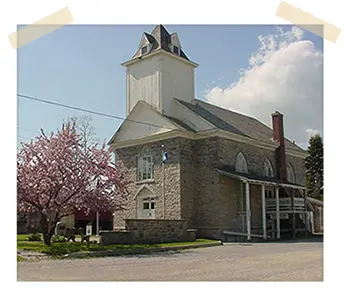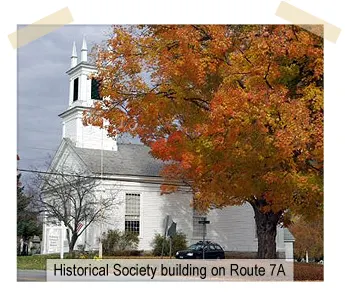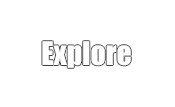
Cole Hall is located on the north side of Buck Hill Road, a few hundred feet from Route 7A. It was built in 1834 by Uriah Cole with stone quarried from the nearby Cole Farm, and originally housed a Universalist Church. In later years the Cole heirs donated the property to the town with the understanding it could be used for no religious sect except the Universalist but could be used for town purposes. It became a Community center; town meetings were held there as well as events by the Garden Club and other groups. In 1973 the selectboard decided to move the town office into Cole Hall after some renovations had to be undertaken. The building is on the State Register of Historic Places. It stands in a prominent position in the village and has become known as a landmark.

Welcome to Shaftsbury, Vermont, a small town of 36 square miles, which still resounds with the energy, passion, fury and sacrifice of those who pioneered here seeking a different life for themselves and their families.
Shaftsbury was chartered on August 20, 1761 and given 23,040 acres of land, in 66 shares. Those shares included one for the Society for the Propagation of the Gospel, one for the Church of England, one for the first settled minister, and one for the benefit of a school.
The first meeting of the Proprietors of the Town of Shaftsbury was held in Bennington on March 9, 1762. It was not until 1765 that the meeting took place in Shaftsbury at the home of Mr. Samuel Waters, Jr.
Historic Route 7A runs through the center of Shaftsbury from the Bennington line to Arlington. This was once the footpath used by the Green Mountain Boys as they patrolled this newly settled territory. In the 1770's, these Green Mountain vigilantes physically harassed and mentally outfoxed agents from Albany, capital of the hated colonial province of New York, whose agents were "sheriffs" and sought to exercise jurisdiction, and surveyors who tried to measure out the land previously purchased by the patriots. The Vermonters farmed small tracts within self-governing townships. New York leaders, on the other hand, preferred large, wealthy landowners for whom tenant farmers worked.
The victorious Battle of Bennington on August 16, 1777 was fought on a hill in Walloomsac, N.Y. about 5 miles west of Shaftsbury. The Bennington Battle Monument commemorating this skirmish, built in Old Bennington, and visible from Shaftsbury, is approximately 5 miles south of Shaftsbury. Many members of The Green Mountain Boys were Shaftsbury residents. They were joined by New Hampshire militia units who traveled through Shaftsbury in order to defeat the British forces before they could capture a munitions dump in Old Bennington.
The town's first cash crop was the manufacture of salts, made by burning hardwood trees to ashes. The "salts" were sold to manufacturers of pearl ash, an important compound used in making soap and glass.
By 1825, 728 "scholars" were in Shaftsbury schools. In 1832, the number had increased to 774. Due to slower transportation 150 years ago, the town's 2,000 people were more segregated in active, discrete, self-contained hamlets. There were 18 autonomous school districts in town, each covering about two square miles, each with its own little one-room school (the implicit community center) and independent school board. Of course, the children walked to school back then, and many continue to do so today as well. However, in 1955, the Shaftsbury voters authorized construction of a new elementary school building that continues to serve the town today, albeit with a few new additions. And, there is only one school board in town today.
That New England tradition of an annual "Town Meeting" occurs each year in Shaftsbury. Important debates and decisions about Town spending like; community appropriations and expenditures, and many other matters, are discussed among voters at these meetings. Neighbors express their views, and town officials listen.
Many of the structures in Shaftsbury are original buildings. West on Church Street is the active Methodist Church built in the 1870's. Two miles north on Route 7A the Shaftsbury Historical Society Museum is housed in the oldest Baptist Church in Vermont, founded in 1768.
Farming was a mainstay for residents in Shaftsbury during the last century. In the 1800's, sheep farming and dairying were common. In 1880, there were 246 large and small farms. However, during the 1900's, farming declined, and today there are fewer than a half dozen working farms in town.
The same can be said for the town's industrial base. In the 1800's, the town abounded with a great diversity of small primary industries that no longer exist today. Among those no longer here are the famous Burden Iron smelter on Route 67, the Barton Tannery on Route 7A in Center Shaftsbury, the flax mills, sawmills and cider mills on practically every major stream in town. The oldest continuing operating manufacturing plant in Vermont, Stanley Tools (formerly known as Eagle Square), closed in 2001. The largest employer in Shaftsbury today is William E. Dailey, Inc. a subsidiary of Peckham Industries. A Sand, Gravel, and Pre-stressed Concrete facility which covers many acres in town. Also, there are many entrepreneurs and self-employed business people in Shaftsbury.
One can swim at either end of town in Lake Paran or Lake Shaftsbury; fishing is possible in many streams that traverse the town; small shops and craftsmen abound; horseback riding is common; and in the winter the trails are perfect for cross-country skiing.
The people of Shaftsbury are gracious, soft-spoken, and hard working. Many who live here are descendents from original settlers in town. The White Creek passing through the northwestern part of town would be familiar to the original settlers as would Paran Creek. Going north, the Governor Galusha rock still stands beside the highway. There are no high-rise apartments and no billboards to obscure the Monroe-Hawkins house or the Governor Galusha house (Jonas Galusha - Governor of Vermont - 9 terms). The poet, Robert Frost once resided in Shaftsbury; people can visit the Robert Frost Stone House Museum where he wrote "Stopping by Woods on a Snowy Evening;" his grave is located in the cemetery at Old Bennington. Silas Hawes, the inventor of the steel carpenter's square lived here in 1815. And the founder of the Republican Party, Jacob Merritt Howard, also lived in Shaftsbury.
Shaftsbury retains its rural and rustic atmosphere today. Deer come down to the streams. Pheasants cross the roads. Ducks fly overhead in the fall and spring and land on Lake Paran and Lake Shaftsbury, honking in flight to alert all to their passing. Vermont's Green Mountains are visible and a scenic delight, especially in October during fall foliage, when thousands come from all over the United States to visit and see the wondrous colors. Yes, Shaftsbury is a wonderful place. Please come visit us.
Town of Shaftsbury, VTPO Box 40961 Buck Hill Road 05262 Phone: (802) 442-4038 Fax: (802) 442-0955 |
||||
| Contact Us |





